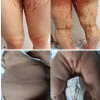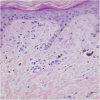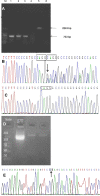NEMO Gene Mutations in Two Chinese Females with Incontinentia Pigmenti
- PMID: 35547601
- PMCID: PMC9084220
- DOI: 10.2147/CCID.S363683
NEMO Gene Mutations in Two Chinese Females with Incontinentia Pigmenti
Abstract
Purpose: To identify the mutations of the NEMO gene in two Chinese females with incontinentia pigmenti.
Patients and methods: Patients were both from Nanchong, Sichuan Province. Genomic DNA was extracted from the peripheral blood of patients and patient 1's father. The mutations of the NEMO gene in patient 1 by GAP polymerase chain reaction and Sanger sequencing and her father were detected. NEMO-specific polymerase chain reaction and Sanger sequencing were used to identify the NEMO gene mutation in patient 2.
Results: DNA analysis identified a rare frameshift mutation, c.723_c.724insCAGG(p.A242QfsX15) in exon 5 of the NEMO gene in patient 1 with a family history but not in her healthy father. The common deletion of exons 4-10 of the NEMO gene was found in sporadic patient 2.
Conclusion: Our data revealed that the rare frameshift mutation, c.723_c.724insCAGG(p.A242QfsX15) in exon 5 of the NEMO gene in patient 1 and the deletion of exons 4-10 of the NEMO gene in patient 2 could cause the occurrence of IP. Genetic testing is helpful for early diagnosis and genetic counseling for families.
Keywords: Chinese; NEMO gene; NF-κB pathway; incontinentia pigmenti; mutation.
© 2022 Jiang et al.
Conflict of interest statement
The authors report no conflicts of interest in this work.
Figures



Similar articles
-
NEMO gene mutations in Chinese patients with incontinentia pigmenti.J Formos Med Assoc. 2010 Mar;109(3):192-200. doi: 10.1016/S0929-6646(10)60042-3. J Formos Med Assoc. 2010. PMID: 20434027
-
[NEMO Delta 4-10 deletion of NEMO gene in Chinese incontinentia pigmenti cases].Zhonghua Er Ke Za Zhi. 2005 Feb;43(2):89-92. Zhonghua Er Ke Za Zhi. 2005. PMID: 15833158 Chinese.
-
A recurrent deletion in the ubiquitously expressed NEMO (IKK-gamma) gene accounts for the vast majority of incontinentia pigmenti mutations.Hum Mol Genet. 2001 Sep 15;10(19):2171-9. doi: 10.1093/hmg/10.19.2171. Hum Mol Genet. 2001. PMID: 11590134
-
NEMO gene rearrangement (exon 4-10 deletion) and genotype-phenotype relationship in Japanese patients with incontinentia pigmenti and review of published work in Japanese patients.J Dermatol. 2013 Apr;40(4):272-6. doi: 10.1111/1346-8138.12091. Epub 2013 Feb 11. J Dermatol. 2013. PMID: 23398170 Review.
-
EDA-ID and IP, two faces of the same coin: how the same IKBKG/NEMO mutation affecting the NF-κB pathway can cause immunodeficiency and/or inflammation.Int Rev Immunol. 2015;34(6):445-59. doi: 10.3109/08830185.2015.1055331. Epub 2015 Aug 13. Int Rev Immunol. 2015. PMID: 26269396 Review.
Cited by
-
Novel IKBKG gene mutations in incontinentia pigmenti: report of two cases.Front Med (Lausanne). 2023 Dec 19;10:1303590. doi: 10.3389/fmed.2023.1303590. eCollection 2023. Front Med (Lausanne). 2023. PMID: 38173938 Free PMC article.
-
An efficient molecular genetic testing strategy for incontinentia pigmenti based on single-tube long fragment read sequencing.NPJ Genom Med. 2024 May 29;9(1):32. doi: 10.1038/s41525-024-00421-z. NPJ Genom Med. 2024. PMID: 38811629 Free PMC article.
References
-
- Fryssira H, Kakourou T, Valari M, Stefanaki K, Amenta S, Kanavakis E. Incontinentia pigmenti revisited. A novel nonsense mutation of the IKBKG gene. Acta Paediatr. 2011;100:128–133. - PubMed
-
- Fusco F, Conte MI, Diociauti A, et al. Unusual Father-to-Daughter Transmission of Incontinentia Pigmenti Due to Mosaicism in IP Males. Pediatrics. 2017;140:20162950. - PubMed
-
- Aradhya S, Woffendin H, Jakins T, et al. A recurrent deletion in the ubiquitously expressed NEMO (IKK-gamma) gene accounts for the vast majority of incontinentia pigmenti mutations. Hum Mol Genet. 2001;10:2171–2179. - PubMed
-
- Has C, Danescu S, Volz A, Noh F, Technau K, Bruckner-Tuderman L. Incontinentia pigmenti in a newborn with a novel nonsense mutation in the NEMO gene. Br J Dermatol. 2007;156:378–410. - PubMed
Publication types
LinkOut - more resources
Full Text Sources
Miscellaneous

